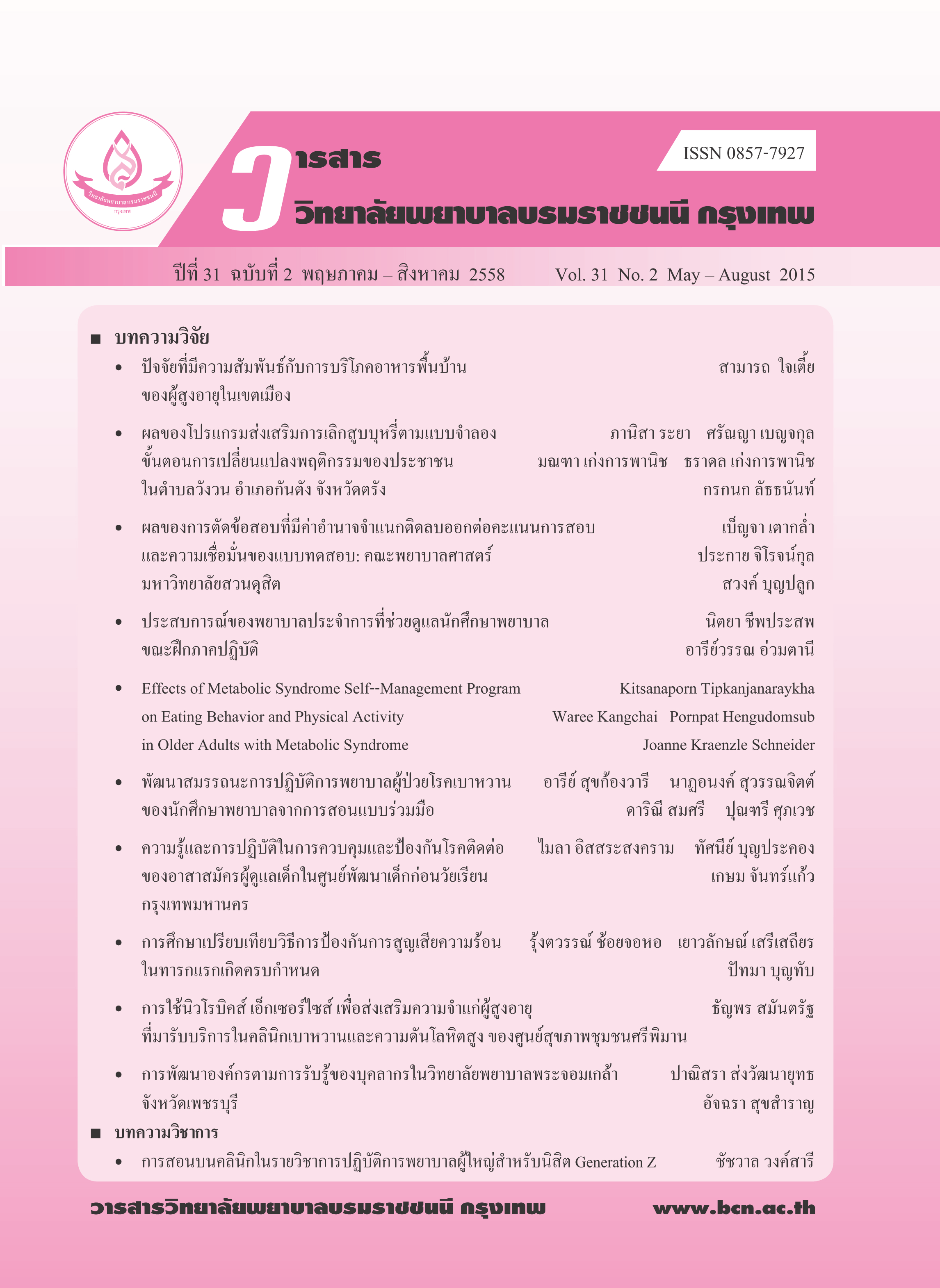ผลของการใช้นวัตกรรมผ้าห่มเย็นต่อการลดอุณหภูมิร่างกาย ในผู้ป่วยศัลยกรรมระบบประสาทและสมองที่มีอุณหภูมิร่างกายสูง THE EFFECTS OF USING INNOVATIVE COLD PACK BLANKET TO REDUCE BODY TEMPERATURE IN BRAIN & NEUROSURGERY PATIENTS WITH HYPERTHERMIA
คำสำคัญ:
นวัตกรรมผ้าห่มเย็น, อุณหภูมิร่างกายสูง, ผู้ป่วยศัลยกรรมระบบประสาทและสมอง, innovation in cold pack blanket, hyperthermia, brain neurosurgery patientบทคัดย่อ
บทคัดย่อ
การวิจัยครั้งนี้เป็นการวิจัยแบบกึ่งทดลอง มีวัตถุประสงค์เพื่อศึกษาผลของการใช้นวัตกรรมผ้าห่มเย็น ต่อ การลดอุณหภูมิร่างกายโดยเปรียบเทียบการใช้ผ้าห่มเย็นกับการเช็ดตัวลดไข้ด้วยน้ำธรรมดา ทำการศึกษา ในกลุ่มผู้ป่วยศัลยกรรมระบบประสาทและสมองที่มีอุณหภูมิร่างกายสูง > 38.5 oC จำนวน 20 คน โดยสุ่มเข้ากลุ่ม กลุ่มทดลองได้รับผ้าห่ เย็น และกลุ่มควบคุมได้รับการเช็ดตัวลดไข้ด้วย น้ำธรรมดา กลุ่มละ 10 คน วิเคราะห์ข้อมูลโดยใช้สถิติพรรณนา ค่าสถิติทีไม่อิสระ และการวิเคราะห์ความแปรปรวนร่วม
ผลการวิจัย พบว่า ค่าเฉลี่ย อุณหภูมิร่างกายหลังทดลองของกลุ่มทดลองและกลุ่ม ควบคุมมีค่า ลดลงอย่าง มีนัยสาคัญทางสถิติ (t = 2.35, p < .05 และ t = 4.385, p <.05) และค่าเฉลี่ยของผลต่างอุณหภูมิร่างกายก่อนและหลังทดลองเปลี่ยนแปลงลดลงมีค่ามากขึ้นเมื่อ เวลาเพิ่มขึ้น โดยค่าเฉลี่ยของอุณหภูมิ ที่เปลี่ยนแปลงลดลงหลัง 15 นาที 30 นาที และ 60 นาที ของกลุ่มทดลอง เท่ากับ 0.31 oC 0.60 oC และ 0.83 oC ตามลำดับ และกลุ่มควบคุมเท่ากับ 0.31oC 0.55oC และ0.70oC ตามลาดับ เมื่อเปรียบเทียบผลของ อุณหภูมิร่างกายที่ลดลงหลังวางผ้าห่มเย็น และเช็ดตัวลดไข้ไม่แตกต่างกัน นอกจากนี้ไม่พบภาวะแทรกซ้อน จากความเย็นได้แก่ ผิวหนังไหม้จากความเย็น อาการหนาวสั่น และหัวใจเต้นผิดจังหวะชนิด Ventricular Fibrillation หลังใช้ผ้าห่มเย็น สรุปว่าผ้าห่มเย็นให้ผลในการลดไข้เทียบเท่าการเช็ดตัวลดไข้ด้วยน้าธรรมดา และมีความปลอดภัย เป็นวิธีที่เหมาะสมกับผู้ป่วยที่มีปัญหาบาดเจ็บหลายระบบ จำกัดการเคลื่อนไหว และ ผู้ป่วยที่แพ้ยาลดไข้ วิธีใช้สะดวก ประหยัดเวลา ควรเป็นทางเลือกด้านการพยาบาลในภาวะที่ขาดแคลน บุคลากร
Abstract
This quasi experimental research examined the effectiveness of using cold pack blanket in reducing body temperature in comparison with the room temperature tepid sponge bath. Twenty brain neurosurgery patients who had high fever (body temperature ≥ 38.5 °C) were randomly assigned into the comparison (n = 10) and experimental group (n = 10). Patients in the comparison group received the room temperature tepid sponge bath while patients in the experimental group received the cold pack blanket. The data were analyzed by using descriptive statistics, dependent t-test and one-way analysis of variance (ANOVA).
Findings revealed that mean body temperature of patients were statistical significantly decreased after applying the cold pack blanket and tepid sponge bath (t=2.35, p < .05 and t=4.385, p < .05). There was no significant difference in decreased body temperature when comparing between group using cold pack blanket and tepid sponge bath. Moreover, there were no complications of shivering, ventricular fibrillation, or cold burn wound after using the cold pack blanket.
The cold pack blanket is an innovative intervention, as effective as the tepid sponge bath. The cold pack blanket is a convenience method that saves time and energy of healthcare providers. It is appropriate for patients with high fever, having multiple injuries, immobilized, and allergic to drugs. It should be considered as an alternative nursing intervention, especially in the situation of nursing shortage.
Downloads
ดาวน์โหลด
เผยแพร่แล้ว
รูปแบบการอ้างอิง
ฉบับ
ประเภทบทความ
สัญญาอนุญาต
บทความที่ได้รับการตีพิมพ์ เป็นลิขสิทธิ์ของวารสารวิจัยสุขภาพและการพยาบาล (วิทยาลัยพยาบาลบรมราชชนนี กรุงเทพ) ไม่สามารถนำไปตีพิมพ์ซ้ำในวารสารฉบับอื่น


















